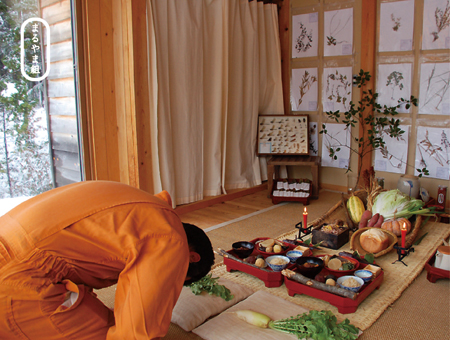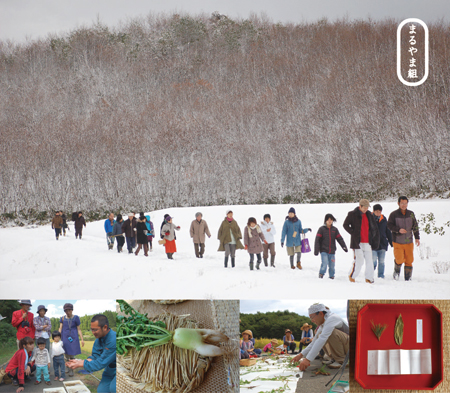conserve eat feel show
Aenokoto
Team Maruyama
“Maruyama,” a satoyama located in Noto Peninsula, is rich in biodiversity and traditional wisdom. Team Maruyama brings together findings from monthly biodiversity surveys and the timeless agricultural ritual, “Aenokoto.” Everyone, who consumes rice, has the right to express his/her appreciation for the living organisms that inhabit the rice paddy fields.
Oku-noto is known for “Aenokoto” (a registered UNESCO cultural heritage), an agricultural ritual in which farmers express their appreciation to the gods and their hopes for a rich harvest. Every December, farmers draw a bath and prepare a meal to welcome the deity from the fields, and they provide hospitality until the deity returns to the fields in February. It is an agricultural ritual performed quietly in every farmer’s home and reflects the region’s identity, culture, and wisdom.
Around the same time, Team Maruyama performs a unique Aenokoto ritual, in honor of the deity who helps rice grow and to celebrate their findings about biodiversity through their monitoring of living organisms in the fields.
The team conducts this ritual on behalf of everyone who eats rice, regardless of whether they are farmers, to express appreciation for a rich harvest and to wish for everyone’s food safety and security.
With a yorishiro (an object that attracts deities) inscribed with the names of all the organisms living in the fields in hand, the team and participants make their way towards the fields to call on the deity. The living room to which the deity is invited is decorated with specimens of vegetation and aquatic insects. Biodiversity is a rather scientific concept, but the team has helped provide opportunities for people to appreciate biodiversity in a less scientific, more natural, cultural environment.
People take a year to prepare this feast for the deity. Learning the hows and whys from the elders, they harvest and cure mountain vegetables and mushrooms in the spring and autumn, cultivate bifurcated radishes and azemame (black beans), and make chopsticks from chestnut wood. The elderly pay close attention to satoyama’s nature, so they know the best seasons and places, so these activities also provide great opportunities to learn the wisdom the elderly have cultivated by living in harmony with their environment.
Traditions and science. At a glance, these 2 themes seem to conflict, but Team Maruyama’s unique Aenokoto brings these 2 themes as well as people from different backgrounds together, like one big family, and helps them rediscover the values satoyama offers. Many people such as non-farmers, consumers, urbanites, and people from abroad have few opportunities to come into contact with Japan’s satoyama or biodiversity, but by transforming biodiversity from being “somebody else’s problem” into “our problem,” food, farming, nature, economy, learning, landscapes and culture will become a more intricate part of our lives.
更新日:2014.10.10 ※記事の内容は投稿当時のものです











